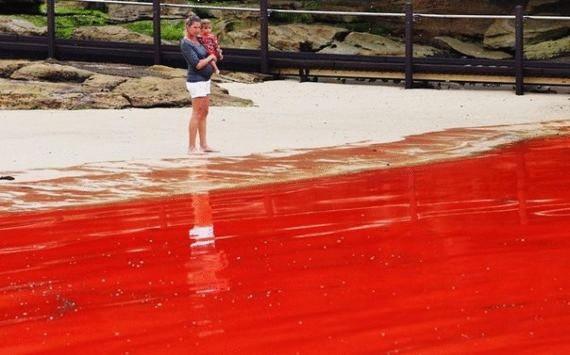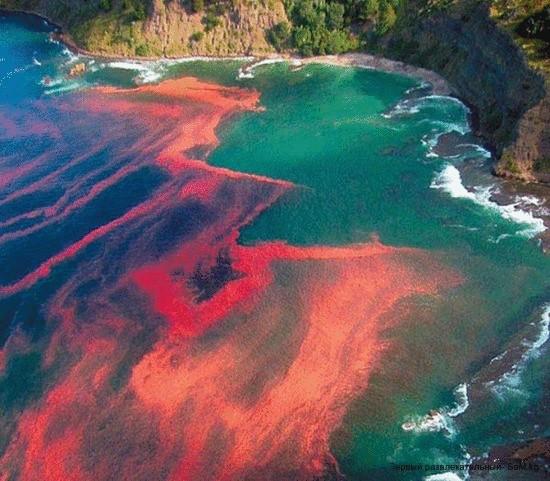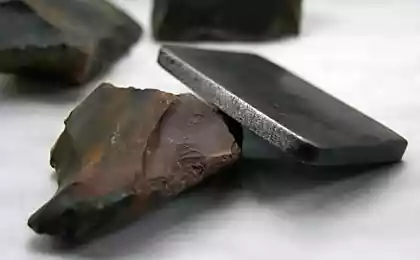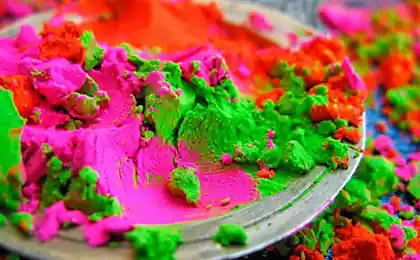458
Red water off the coast of Sydney
Recently, several popular beaches in Sydney — Bondi, Clovelly and Gordon's was temporarily closed in connection with an unusual phenomenon: the waves off the coast was painted a bright red color, which looked like strawberry compote.
But given the hype around December 21 and end of the Mayan calendar not all of the witnesses took the joke nature optimistic, and the foreign media felt obliged to put the fear into the public.

Reporters and journalists decided to play on the feelings of religious people and recalled that the situation in Sydney consistent with the biblical descriptions of the Apocalypse that rivers will turn red as blood, and the smell will be horrible to stand. However uchenym has long been known that rich color and a sharp smell of fish is not caused by mystical causes, and the "marriage season" from microscopic dinoflagellates – Noctiluca scintillans simplest animal capable of photosynthesis. They are also known as "nochesvetka" because they have the ability to glow in the dark " and "light up" the coastal strip, like a sprinkle of magic dust.
Such algal blooms called "red tides". They from time to time observed in different parts of the world: in the waters of the United States, China, Antarctica, Iraq, Iran, Ukraine... and in Australia, this happens not for the first time and though "tides" there is not often, the old-timers still can't surprise red water.

Scientists from the University of Massachusetts found out why the emergence of al plankton so hard to predict — is to blame ocean currents. The different layers of water have different temperatures and are moving with different speed, but sometimes the middle layers happen to be "trapped" between their neighbors and formed an uncharacteristic water "pocket", which accumulated a large number of microorganisms. In the end, this water breaks free somewhere in shallow water, and in the case of warm weather plankton satisfied with the red "revolution". In December, for Australia summer is coming – so nechistoty appreciated the hospitality, starting to bloom and smell".
Noctiluca scintillans is not innocuous: in the "flowering" insidious plankton emit ammonia. Under normal conditions, the dose of toxins is small, but the increase in the mass of dinoflagellates leads to the fact that harmful substances accumulate in fish and shellfish – once on the plate, such seafood is able to cause serious poisoning. And in the extreme situation, when water is transformed into a colorful "ketchup" threatened destruction of fish and birds to eat them. Bathing in red water also can cause skin irritation, but some Australian fans of extreme sports still had enough time to naplesreta in "bloody" water.

In the journal "Applied Acoustics" scientists talk about how to defeat the "red tides" with the help of ultrasound. Researchers found out that wave with a frequency of 1 megahertz resonate in the smallest bubbles of nitrogen contained in the cells that support microorganisms afloat. As a result of these fluctuations of the cell membrane to burst, releasing the gas. As a result, the phytoplankton sinks to the bottom, where it dies without light.
Scientists believe that this method is the most secure available, especially given the fact that ultrasound pretty bad spread in the water. The effective radius of destruction is not more than 20 meters, which will allow you to clean away tiny pests only coastal strip and the upper layers of the water without affecting other parts of the ecosystem.

Source: /users/276
But given the hype around December 21 and end of the Mayan calendar not all of the witnesses took the joke nature optimistic, and the foreign media felt obliged to put the fear into the public.

Reporters and journalists decided to play on the feelings of religious people and recalled that the situation in Sydney consistent with the biblical descriptions of the Apocalypse that rivers will turn red as blood, and the smell will be horrible to stand. However uchenym has long been known that rich color and a sharp smell of fish is not caused by mystical causes, and the "marriage season" from microscopic dinoflagellates – Noctiluca scintillans simplest animal capable of photosynthesis. They are also known as "nochesvetka" because they have the ability to glow in the dark " and "light up" the coastal strip, like a sprinkle of magic dust.
Such algal blooms called "red tides". They from time to time observed in different parts of the world: in the waters of the United States, China, Antarctica, Iraq, Iran, Ukraine... and in Australia, this happens not for the first time and though "tides" there is not often, the old-timers still can't surprise red water.

Scientists from the University of Massachusetts found out why the emergence of al plankton so hard to predict — is to blame ocean currents. The different layers of water have different temperatures and are moving with different speed, but sometimes the middle layers happen to be "trapped" between their neighbors and formed an uncharacteristic water "pocket", which accumulated a large number of microorganisms. In the end, this water breaks free somewhere in shallow water, and in the case of warm weather plankton satisfied with the red "revolution". In December, for Australia summer is coming – so nechistoty appreciated the hospitality, starting to bloom and smell".
Noctiluca scintillans is not innocuous: in the "flowering" insidious plankton emit ammonia. Under normal conditions, the dose of toxins is small, but the increase in the mass of dinoflagellates leads to the fact that harmful substances accumulate in fish and shellfish – once on the plate, such seafood is able to cause serious poisoning. And in the extreme situation, when water is transformed into a colorful "ketchup" threatened destruction of fish and birds to eat them. Bathing in red water also can cause skin irritation, but some Australian fans of extreme sports still had enough time to naplesreta in "bloody" water.

In the journal "Applied Acoustics" scientists talk about how to defeat the "red tides" with the help of ultrasound. Researchers found out that wave with a frequency of 1 megahertz resonate in the smallest bubbles of nitrogen contained in the cells that support microorganisms afloat. As a result of these fluctuations of the cell membrane to burst, releasing the gas. As a result, the phytoplankton sinks to the bottom, where it dies without light.
Scientists believe that this method is the most secure available, especially given the fact that ultrasound pretty bad spread in the water. The effective radius of destruction is not more than 20 meters, which will allow you to clean away tiny pests only coastal strip and the upper layers of the water without affecting other parts of the ecosystem.

Source: /users/276























